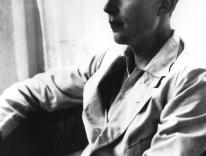 An Italian fellow named Graziano Toni from the northeastern Italian city of Faenza has catapulted holy card collecting into a serious hobby--he has 50,000 cards in his personal collection and has compiled about 2,000 of his finest ones in a 512-page book titled The First International Catalog of Holy Cards, recently published by the Italian firm Unificato.It's a potent mix--devotion and cash. (Like baseball card collecting, I suppose.) Rare or elaborate designs can command some $4,700 at antique markets and collectors fairs. Unfortunately, a central reason for such prices is the increasing scarcity of these cards.RNS's Vatican correspondent Francis X. Rocca hasthe fascinating story, and back story:
An Italian fellow named Graziano Toni from the northeastern Italian city of Faenza has catapulted holy card collecting into a serious hobby--he has 50,000 cards in his personal collection and has compiled about 2,000 of his finest ones in a 512-page book titled The First International Catalog of Holy Cards, recently published by the Italian firm Unificato.It's a potent mix--devotion and cash. (Like baseball card collecting, I suppose.) Rare or elaborate designs can command some $4,700 at antique markets and collectors fairs. Unfortunately, a central reason for such prices is the increasing scarcity of these cards.RNS's Vatican correspondent Francis X. Rocca hasthe fascinating story, and back story:
The history of holy cards begins soon after Johannes Gutenbergs invention of the printing press, in 1440. The same technology that would help spread Protestantism through reformers tracts and Bible translations enabled the proliferation of religious images that Protestant iconoclasts abhorred.During the Catholic Counter-Reformation of the 16th and 17th centuries, evangelizing Jesuit priests were eager distributors of holy cards, particularly among the illiterate.From early on, holy cards were also put to secular use. Notaries often attached them to legal documents to guarantee their legitimacy, and travelers would put them inside trunks as supernatural insurance against theft.[snip]The holy cards age of maximum splendor came in the 17th and 18th centuries, Toni said, when the handiwork of monks and nuns grew increasingly refined. Gems from this period often feature intricate cutting to produce the effect of delicate lace borders, miniature watercolor portraits, and collages made of such luxurious materials as silk, velvet and seed pearls.In the 19th century, a more efficient way to reproduce images (lithography) transformed holy cards into a mass market industry, with images commonly circulating by the thousands.Large-scale production hardly meant the demise of quality, Toni said, pointing to the vivid colors and fine lines that distinguish outstanding work in the 1800s. It was during this period, amid rising literacy rates, that prayers commonly appeared on the flip side of a saints image.The 20th century, especially the period since World War II, has witnessed the decline of holy cards in both quality and popularity.
The morale of the story: Hold on to your holy cards. Better yet, start using them again.(RNS photo: A French steel engraving from the middle of the 19th century, portraying an unnamed pilgrim. The caption reads, "Pilgrimage is an offering to God." From the first international catalog of holy cards.)


